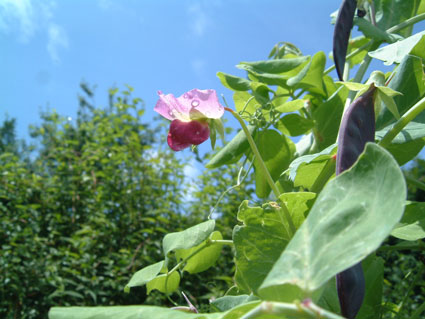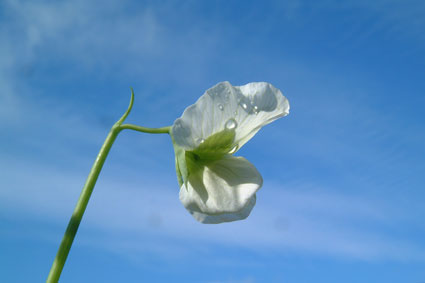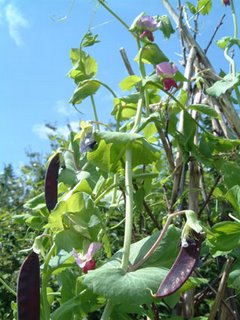 Mr Bethell's Purple Podded
Mr Bethell's Purple PoddedI did some more pea hand-pollinations today as the weather was favourable. The strategy with this batch is to emasculate and pollinate the flowers today and then go back and give them another pollen dusting over the next day or so. I'm hoping this might increase the success rate a little, although I've now looked it up in a book and it seems that the female parts of pea flowers mature earlier than the males anyway, so the stigma should be receptive whether it's pollinated the same day as emasculation or not. But it's worth trying different strategies. I needed something to mark these out separately from the ones I've already done, and didn't have any more string. So I've been tying these with some gold braid I found in my sewing box, which is a bit extravagant, but it certainly looks very pretty.
Slight problem though ... I'm running out of Alderman buds. This variety was sown a while before the others and the plants are coming to the end of their flowering cycle. I need to ensure I get enough successful pollinations to produce seed for the next part of the experiment. Luckily I don't need many ... even half a dozen viable seeds would be enough to proceed with. But I do have to ensure I end up with something ... otherwise I'll have to start again next year. I managed to pollinate five buds with Mr Bethell's Purple Podded. And to increase the chances of getting something useable I also pollinated a few buds of Mr Bethell's Purple Podded using Alderman pollen, i.e. the same cross but with the parents the opposite way round.
 Alderman flower
Alderman flowerThere is a good reason why I've only used Alderman as the 'mother' plant until now. Alderman is a true-breeding green-podded variety; it has no trace of purple whatsoever. So if I hybridise it with a purple variety and grow the seed, and some of the resulting plants are purple, I will know for certain that those plants are the result of a successful cross. If some of the plants turn out green, I can probably assume they were the result of the bud having self-pollinated before I got to it. This is because the gene for purple colouring is dominant, so I am expecting all the plants of the first (F1) generation to be purple if they crossed successfully (I can't be 100% sure about that, since other unknown factors may turn out to screw things up, but it's a reasonable assumption at this stage). Being able to accurately identify the successful crosses in the F1 generation will save me time and heartache.
Genetically there's no difference between an Alderman x Purple Podded and a Purple Podded x Alderman cross. They should both yield the same results in subsequent generations. But if I use the purple podded variety as the mother, it's harder to recognise the offspring. All the plants grown from its seed will (theoretically) turn out purple, regardless of whether it crossed with itself or with Alderman. The green-podded gene carried by Alderman is recessive so I wouldn't expect to see it at all in the F1 generation. I would have to rely on other factors to identify the successful crosses by looking for other Alderman attributes, which may or may not be apparent (in which case I'd have to grow out the next generation where the various genes will begin to segregate). If the F1 generation turns out to be purple with big fat sweet-tasting peas, or has white flowers, then I can assume it's a successful cross with Alderman. If it doesn't, I'm none the wiser.
So that's why I've only used Mr Bethell's Purple Podded as a 'father' until now. But the shortage of appropriate sized buds on Alderman means I now have to hedge my bets a little.
Doing the cross in reverse today has really shown me how variable pea buds are in their maturity. I said in my earlier post that the buds were about right just as the petals began to protrude from the sepals, but that's only a starting point. In search of Alderman pollen I cut into a young bud which was only just starting to open ... only to find the pollen was all spent. The stamens were withered and the only traces of pollen were white and dusty and useless. Clearly Alderman buds complete their pollination process long before the flowers open, and I had to open up some very small buds to find any viable pollen. Conversely, Mr Bethell's Purple Podded still has copious amounts of pollen when the flowers are fully open, and may even still be viable as the flower dies off. This makes all my hand-pollination efforts a matter of trial and error ... because I don't really know which buds are going to work best. That's why I'm doing lots of them.

Also today I sowed some more Alderman seeds in my trusty bog roll tubes. Sowing peas in July? Well, in a sheltered garden within Cheltenham's benign microclimate I think I can get away with it. I would also like to sow at least a few seeds from my hybrid experiment this year if they mature in time. That would mean I could start next year with an F2 generation, which would be perfect. The F2 generation is the one where all the interesting stuff starts happening as the genes from the F1 start to separate out into various combinations. That's the one I want. The purpose of the F1 generation is solely to produce as much F2 seed as possible. So if I can do that before September then so much the better.
I'm partly growing more Alderman because it's lovely and I want to eat it, but also because I want it for backcrossing. Assuming I do sow some of my F1 seeds this year, one of the things I'll want to experiment with is hand-pollinating some Alderman buds with the F1 hybrid pollen. The resulting cross will be a quarter Mr Bethell's Purple Podded and three-quarters Alderman. And if I select any that are purple, and then do the same again (backcrossing them with Alderman) then within a few generations I should end up with a plant which is essentially Alderman but with purple pods. If it works, I could have one of the most beautiful and tastiest pea varieties around.
1 comment:
I enjoyed your story about breding alderman with purple podded peas. I once thought after I become a more experience gardener, I would try something like that. It is almost too hot for peas her in Texas, so winter peas do much better, unless frost gets them. If you are successful, these will be more frost tolerant than green peas. If you ever succeed, I would sure love to obtain some seeds from you. (either a seed trade or to purchase them)
keep up the good work. I am sure it is tedious!
Mary
Post a Comment